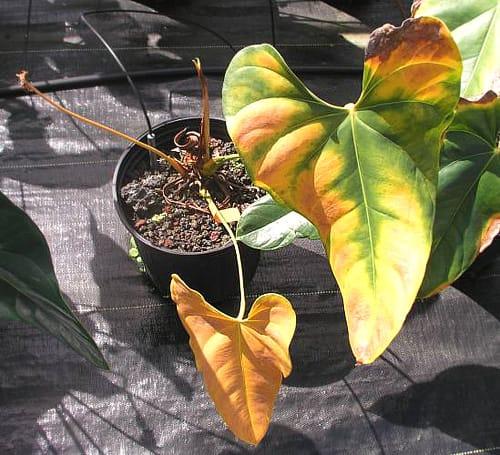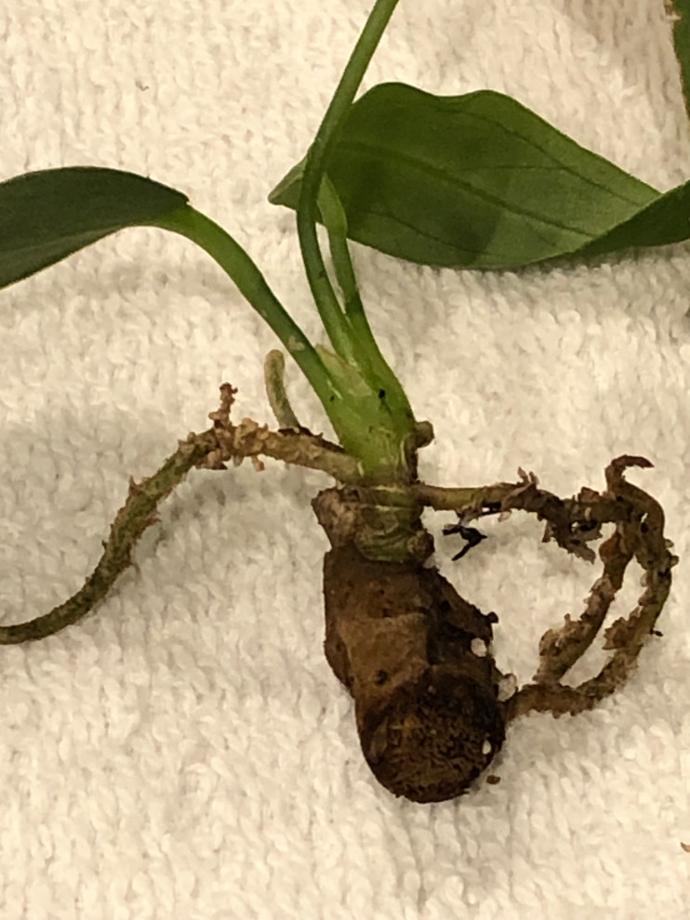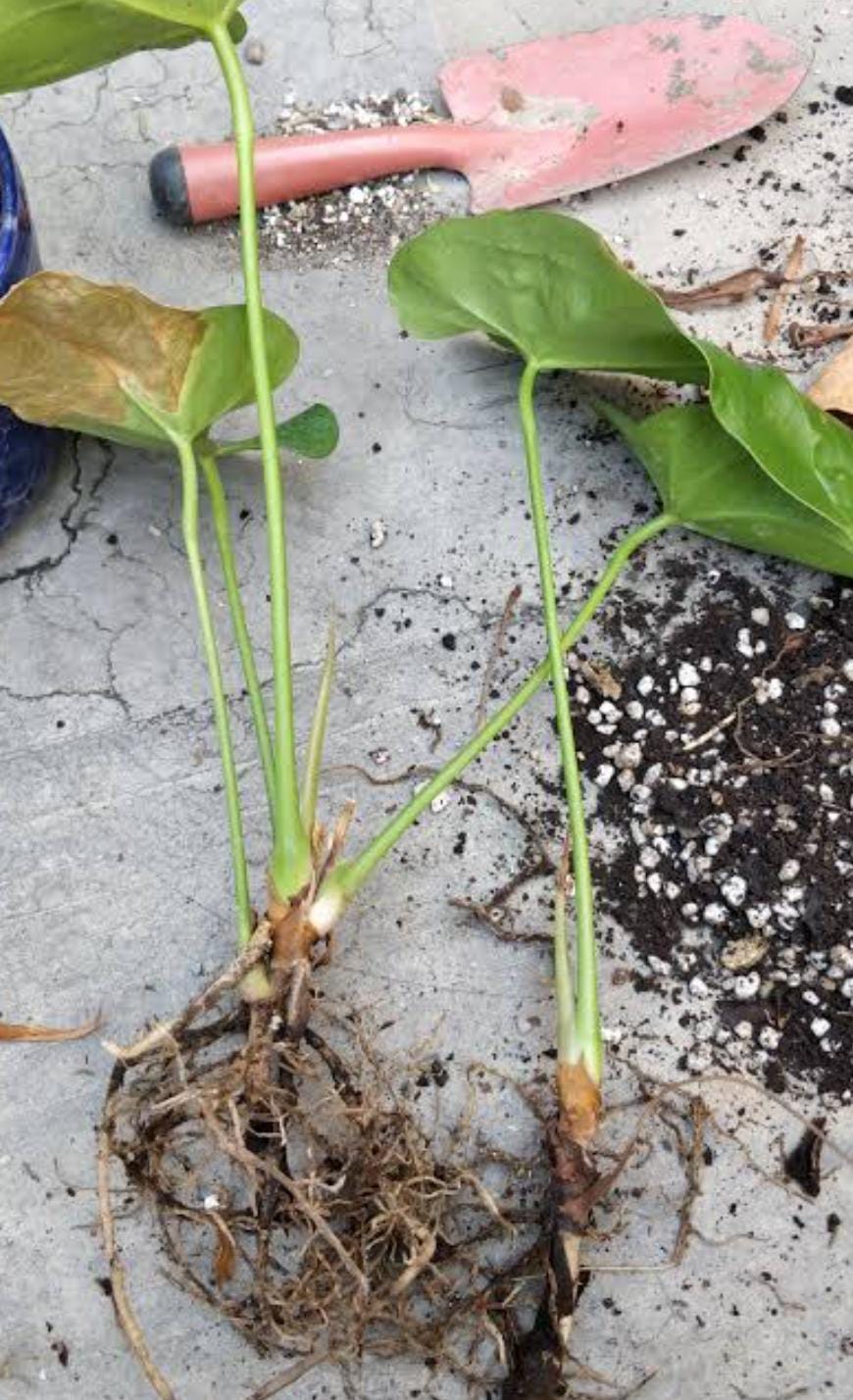Anthurium Plant
ANTHURIUM, also known as Lace-leaf or Flamingo Flower, is a tropical plant with glossy, heart-shaped leaves and unique flowers. Plant in well-draining soil with bright, indirect light. Keep the soil consistently moist and provide high humidity for optimal growth and flowering.
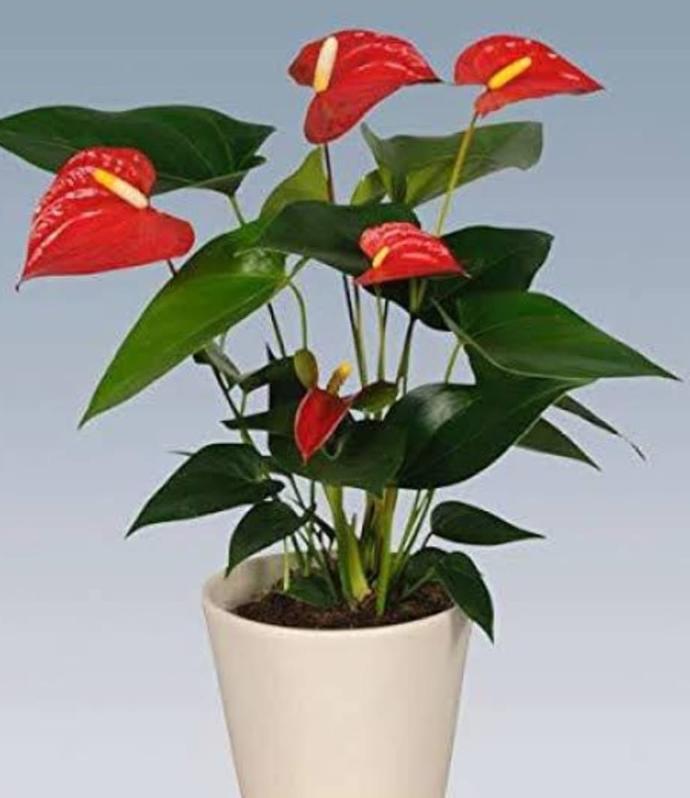
Habit
Perennial
Height
6-24 inches
Growth
Moderate
Soil
Well Drained, Loose
Shade
Bright , indirect light
Moisture
Moist
Edible
Yes [Fruit]
Medicinal
Yes
Origin
South America
Climatic Condition
Tropical, Humid
Temperature (°)
18-26
Humidity (%)
60-80%
Potting media
Peat+Perlite
Fertilizers
Balanced NPK(10:10:10)
Watering
Keep Moist
Plant Weight
100-150 g
Flowering Time
Year round
Soil Ph level
5.5-6.5
Water Ph level
6.0-6.5
Soil EC
0.8 dS/m
Yield Per Plant
Moderate Yield
NPK ratio
10:10:10
life Span
3-5 yrs
Health Benefits
Suggested Grow Media or Potting Mix ?
50% peat moss, 25% perlite, 25% orchid bark
Suggested Fertigation/Fertilizers
Fertilize every 2 weeks with a high-phosphorus fertilizer.
Common Diseases and Remedies
Root rot , bacterial blight.
Yellowing leaves, wilting, mushy and dark roots. Dark lesions on leaves, water soaked appearance, and eventual collapse.
Repot in well draining soil, avoid overhead watering.
HEALTH BENEFITS
Anthuriums, also known as Anthurium andraeanum, are popular ornamental plants that are not only beautiful but can also provide various health benefits, especially when kept as houseplants. Here are some of the key health benefits:
- Air Purification: Like many houseplants, anthuriums can help purify the air by removing toxins such as formaldehyde and ammonia. They contribute to a healthier indoor environment by improving air quality.
- Humidifying: Anthuriums release moisture into the air through a process called transpiration, which can help maintain optimal humidity levels in dry indoor environments. This can be beneficial for respiratory health, particularly in areas with low humidity or during winter months.
- Mood Enhancement: Having plants like anthuriums in your living or working space has been linked to reduced stress and anxiety. The presence of plants can improve mood and create a more peaceful atmosphere.
- Aesthetic Value: Beyond the direct health benefits, the bright and beautiful flowers of the anthurium can add to the aesthetic appeal of your space, which can contribute to a positive mental state and well-being.
- Oxygen Generation: As with most plants, anthuriums undergo photosynthesis and release oxygen into the air, which can contribute to better air quality, particularly in rooms with poor ventilation.
While the anthurium is beneficial in these ways, it’s important to keep in mind that the plant is toxic if ingested, so it's best to keep it out of reach of pets and small children.
What Is An Anthurium Plant ?
Anthurium plants, also known as flamingo flowers or lace-leaf, are tropical flowering plants native to Central and South America. They are prized for their glossy, heart-shaped leaves and vibrant, often red, pink, or white spathes (modified leaves) that surround the tiny flowers on a spike called a spadix. Anthuriums are popular as houseplants due to their striking appearance and relatively low maintenance requirements. They thrive in warm, humid environments and can add a touch of exotic beauty to any indoor space.

What Are The Different Types Of Anthurium Plants?
1. Anthurium andreanum
This is the most common type, known for its heart-shaped, glossy leaves and colourful spathes. It comes in various shades of red, pink, white, and even green.
2. Anthurium scherzerianum
Also called the "flamingo flower," this type typically has smaller, more waxy flowers in shades of red, orange, or pink. The spathes are often curled or twisted, giving them a distinctive appearance.
3. Anthurium crystallinum
This variety is prized for its large, velvety leaves with silvery veins. The flowers are usually greenish-white and inconspicuous compared to the striking foliage.
4. Anthurium clarinervium
Known for its dark green, heart-shaped leaves with prominent white veins, this type is highly sought after by collectors for its striking foliage.
5. Anthurium veitchii
This species has deeply lobed leaves with a velvety texture and silver veining. The flowers are usually small and greenish-white, but the foliage is the main attraction.
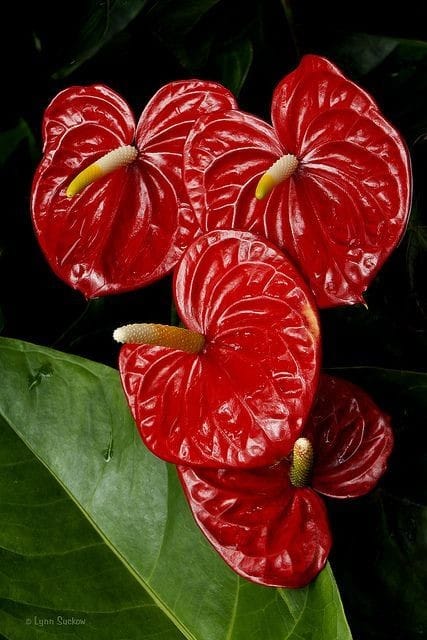
How to Care Anthurium Plants ?
1. Location
Anthurium plants can be grown both indoors and outdoors, depending on the climate and specific care requirements. Here's a breakdown:
Indoor Anthuriums: Anthuriums are commonly grown as indoor houseplants due to their tropical origins and preference for warm, humid conditions. Indoors, they thrive in bright, indirect light, making them suitable for placement near a window with filtered sunlight. They prefer temperatures between 65-80°F (18-27°C) and benefit from consistent humidity levels, which can be achieved through regular misting or by using a humidifier. Indoor Anthuriums can add a touch of exotic beauty to living rooms, bedrooms, or office spaces.
Outdoor Anthuriums: In regions with mild, tropical climates, Anthurium plants can be grown outdoors in shaded or partially shaded areas. They are often cultivated in gardens or as landscape plants in areas where temperatures and humidity levels remain within their preferred range. Outdoor Anthuriums require protection from direct sunlight, especially during the hottest parts of the day, as intense sunlight can scorch their leaves. In cooler or temperate climates, Anthuriums can be grown outdoors during the warmer months and brought indoors when temperatures drop.
2. Sunshine
Anthurium plants prefer bright, indirect light. This means they thrive in an environment where they receive plenty of light, but it's filtered or diffused rather than direct sunlight.
3. Soil
Anthurium plants thrive in well-draining soil that retains some moisture while allowing excess water to drain away.
4. Hydration
Proper hydration is crucial for the health of an Anthurium plant. Here's a guide to watering your Anthurium effectively: Water your Anthurium plant consistently, allowing the top inch (2.5 cm) of soil to dry out slightly between waterings. Avoid letting the soil dry out completely or become waterlogged. Anthuriums typically require watering about once a week, but this can vary depending on factors such as temperature, humidity, and pot size. Adjust your watering schedule accordingly, checking the soil moisture regularly.
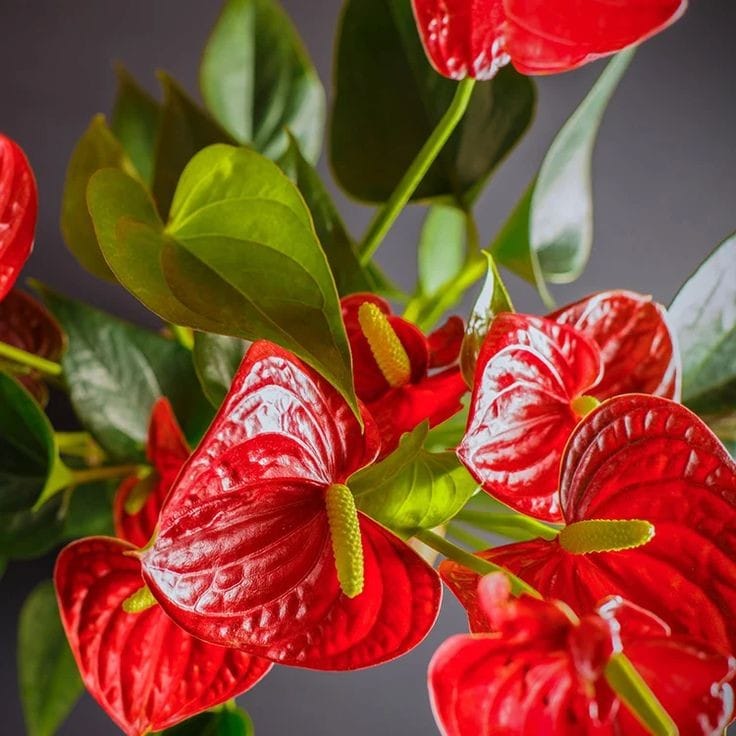
5. Nourishment
Anthurium plants generally prefer a balanced fertilizer with an NPK ratio around 20-20-20 or similar. This provides them with essential nutrients in proportion: Nitrogen (N) for leaf growth, Phosphorus (P) for root development and flower production, and Potassium (K) for overall plant health and disease resistance. Always follow the manufacturer's instructions for proper application.
6. Issues
Anthurium plants may face problems like root rot due to overwatering or poor drainage. Additionally, pests like aphids, scale, or mealybugs can affect them. Ensure well-draining soil, let the topsoil dry between waterings, and maintain proper humidity. Use insecticidal soap for pests. Yellowing leaves may indicate overwatering, while brown tips could result from low humidity. Regularly inspect your plant for signs of issues and adjust care accordingly. If you provide more details, I can offer more specific advice.
What are the Benefits of Anthurium Plants ?
1. Anthuriums are known for their ability to remove toxins such as formaldehyde, xylene, and ammonia from the air, thus improving indoor air quality. Anthuriums produce beautiful, colourful flowers and glossy, attractive leaves, making them popular ornamental plants for homes and offices. Anthurium flowers can last for several weeks to months, providing long-lasting beauty and enjoyment. Anthuriums are relatively easy to care for and require minimal attention, making them suitable for both experienced and novice gardeners. Overall, Anthurium plants are not only aesthetically pleasing but also contribute to a healthier indoor environment and can uplift the mood and energy of the space they inhabit.

FAQs About Growing Anthurium Plants
1. How to maintain anthurium plant ?
1. Place your Anthurium in bright, indirect light. Avoid direct sunlight, as it can scorch the leaves. Keep the plant in a warm environment with temperatures between 65-80°F (18-27°C). Avoid cold drafts and sudden temperature changes. Water your Anthurium thoroughly when the top inch of soil feels dry to the touch, but avoid overwatering, as it can lead to root rot. Ensure good drainage, and never let the plant sit in water. Anthuriums thrive in high humidity environments. Mist the leaves regularly or place the pot on a tray filled with pebbles and water to increase humidity around the plant. Feed your Anthurium with a balanced liquid fertilizer diluted to half strength every 4-6 weeks during the growing season (spring and summer). Reduce fertilization during fall and winter. Remove any yellowing or dead leaves and spent flowers promptly to maintain the plant's appearance.
2. What are the uses of anthurium plant ?
Anthuriums are primarily grown for their attractive foliage and long-lasting flowers, making them popular as decorative indoor plants in homes, offices, and public spaces. Anthurium plants are known for their ability to purify indoor air by removing toxins such as formaldehyde, xylene, and ammonia, thus improving air quality. Anthuriums are often given as gifts due to their beauty and symbolism. They are commonly used in flower arrangements, bouquets, and as potted plants to add colour and elegance to any space. In some cultures, Anthuriums have traditional medicinal uses. For example, in certain regions of South America, Anthuriums are used in herbal remedies for various ailments.
3. Can I grow anthurium plant indoors ?
Yes, Anthurium plants are well-suited for indoor growing and are popular choices for indoor houseplants. They thrive in indoor environments as long as their basic care requirements are met.
4. Which pot is best for growing area for anthurium plant ?
For growing Anthurium plants, it's essential to choose a pot that provides adequate drainage and space for root growth. Here are some considerations for selecting the best pot: Choose a pot with drainage holes at the bottom to allow excess water to drain freely. Anthuriums are susceptible to root rot if their roots sit in waterlogged soil for too long. Select a pot that is slightly larger than the plant's current root ball, with about 1-2 inches of space around the sides. Avoid pots that are too large, as excessive soil volume can lead to waterlogging and root rot. Optimum for pots made of porous materials like terracotta or clay, as they allow for better airflow and moisture regulation. Plastic pots are also suitable but may require more attention to watering to prevent water retention. Anthuriums have shallow root systems, so a pot with a moderate depth (about 6-8 inches) should be sufficient. Avoid pots that are too deep, as they can hold excess moisture and lead to root rot. Ultimately, the best pot for growing Anthurium plants is one that promotes good drainage, provides ample room for root growth, and suits your aesthetic preferences. Remember to repot your Anthurium as needed to prevent it from becoming root-bound and to refresh the potting mix.
5. From where I can shop for anthurium plant ?
1. Visit local nurseries or garden centres in your area. They often carry a variety of indoor plants, including Anthuriums, and can provide guidance on care and maintenance. Many large home improvement stores and chain garden centres stock Anthurium plants in their indoor plant sections. Numerous online retailers specialize in selling indoor plants and offer a wide selection of Anthurium varieties. Websites like Amazon, Etsy, and specialized plant shops often have Anthuriums available for purchase and can deliver them directly to your door. Look for specialty plant shops or botanical gardens in your area that focus on indoor plants. They may have a diverse selection of Anthuriums and can provide expert advice on caring for them. Check for plant expos, farmers' markets, or plant swaps in your area where you can purchase Anthurium plants directly from growers or collectors. Before purchasing an Anthurium plant, make sure to inspect it for signs of health and choose a specimen with vibrant foliage and no visible pests or diseases.
